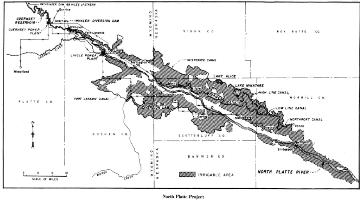When the early fur trappers and traders traveled through the North Platte Valley seeking
the beaver in the first decades of the nineteenth century, they were among the first Euro-Americans
to visit the region west of the 100 meridian. The trails they helped blaze led the later
immigrants across the land to the northwest territories and established the first trading posts
at Fort Laramie and Fort Casper in the Wyoming region. Following in the wake of the pioneers, who
crossed the prairies to the green lands of Oregon and Washington, were the cattlemen who saw the
open range as the space necessary for their livestock. But within the last two decades of the
nineteenth century, homesteaders decided to stay in Wyoming and Nebraska, fighting the cowmen,
the blizzards, and the droughts.
Although not receptive to the idea of irrigation as a means of watering the land initially,
the farmers along the North Platte saw that increases in agricultural production were possible when
they no longer relied solely on rainfall. They dug canals, used water wheels, and while envisioning
the cultivation of 60,000 acres along the North Platte, they were lucky to irrigate between 5,000
and 8,000 acres with the limited water supply. As with most locations in the arid West, local capital
or private investors could not raise the funds necessary to construct dams to store enough water for
the irrigable lands. Surveys had been prepared at the turn of the century for the construction of
irritation works, but it was not until Wyoming Senator F. E. Warren helped with the passage of the
national reclamation bill was there hope for the lands along the North Platte.[1]
As possible recognition for Warren's assistance as well as the Nebraska congressional delegation's
efforts in enacting the National Reclamation Law, Secretary of the Interior Hitchcock authorized the
Sweetwater Project, later known as the North Platte, as one of the first to be developed by the newly
formed Reclamation Service. Within the space often years, the Pathfinder Dam, cornerstone of the project
and named after the early explorer, John C. Fremont, who traversed the North Platte River and perchance
thought one day that the river would be tamed and provide the necessary life-giving blood to the land,
was completed. The federal engineers constructed a diversion dam and irrigation system, including the
130-miles long Fort Laramie Canal, and the Interstate Canal, over the next two decades, with water being
delivered to the farmers as early as the 1908 irrigation season.[2]
There were immediate signs of success on the North Platte Project with the construction of the
Pathfinder Dam. Agriculture expanded with over a thousand newly irrigated farms by 1912, and during
the next two years, the farm population increased by fifty percent. Livestock, both cattle and sheep,
were brought to the project lands to feed on the crops during the winter. By the mid-i 920s, over two
thousand miles of canals and laterals were constructed on the North Platte Project, bringing water to
about 220,000 acres in both Wyoming and Nebraska. Reclamation engineers resurrected an earlier idea to
construct a regulating reservoir with Guernsey Dam, at Goshen Hole, Wyoming and additional reservoirs,
Lake Alice and Lake Minatare in Nebraska. With the assurance of a water supply, the farmers started
growing "speciality crops," such as sugar beets and alfalfa while continuing to raise potatoes, oats,
corn, wheat, and barley. Under Warren Act contracts, the waters from the North Platte Project's storage
dams are delivered to an additional 100,000 acres.[3]
Although the early reclamation settlers on the North Platte Project now had a water supply, they
still faced other hardships, especially those unfamiliar with irrigation farming. The strong winds often
blew the topsoil away with the newly planted seed and uneven application of water could send it all down
the drainage ditch to the canal or river. Bounties were often placed on grasshoppers and gophers. Many
of the new farmers could not produce enough agricultural crops to pay for all the costs of keeping a
household and paying the reclamation charges too. Those who were successful were usually the farmers who
came from neighboring states or regions and were familiar with the agricultural techniques, such as soil
preparation and crop rotation. After the first World War, the United States gave returning servicemen the
opportunity to farm on the North Platte Project, but while these soldiers and sailors could survive on the
battlefield, few would be productive in raising crops. Farming was not always an easy enterprise on a
reclamation project.[4]
